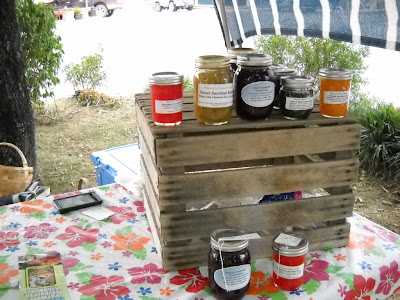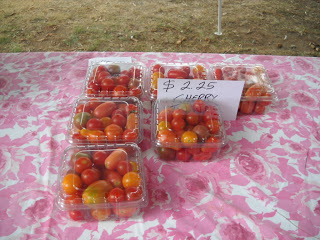

| Visitors Now: | |
| Total Visits: | |
| Total Stories: |

| Story Views | |
| Now: | |
| Last Hour: | |
| Last 24 Hours: | |
| Total: | |
A Tale of Two Markets: Part II Newton County, Arkansas
In my prior post about the farmers markets in Telluride and Mountain Village, Colorado, I promised to compare and contrast those markets with the one in Jasper, Arkansas, my home town. Both places are similar in some ways, dramatically different in others. First, both are rural/nonmetropolitan by most ecological measures, e.g., population density and size. Indeed, both have similar total populations– San Miguel County just over 7000, and Newton County just over 8000. Both are also mountain towns (San Juans of the Rockies on one hand, Ozarks on the other), which benefit from ecotourism. In fact, both are amenity rich in terms of outdoor activities, but Telluride has many more “built” amenities, and is quite cosmopolitan culturally. This distinction and the crowd each county attracts is reflected in the annual accommodation and food service sales for 2007: $77 million in San Miguel County, $3.2 million in Newton County. That and the relative affluence are also reflected in retail sales per capita in 2007: $13,114 in San Miguel County, $1,596 in Newton County.
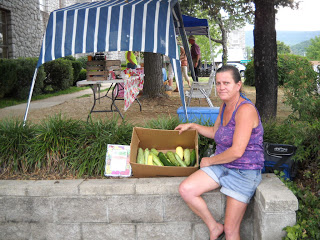 Tensions between old timers and newcomers are evident in both places. In Telluride, those tensions often play out in planning battles, but presumably also in other ways. Newton County does not engage in any planning or regulate building in any way, so these tensions are manifest in other ways. In fact, my sense is that these conflicts have seemingly dissipated over the years, perhaps because long-time residents have come to see newcomers as a net gain to the community.
Tensions between old timers and newcomers are evident in both places. In Telluride, those tensions often play out in planning battles, but presumably also in other ways. Newton County does not engage in any planning or regulate building in any way, so these tensions are manifest in other ways. In fact, my sense is that these conflicts have seemingly dissipated over the years, perhaps because long-time residents have come to see newcomers as a net gain to the community.
Beyond these similarities, the differences between the two places are more apparent. Telluride is an extraordinary example of rural gentrification and is so obviously affluent, Newton County is a persistent poverty county, which means it is characterized by entrenched, inter-generational poverty. I provided some socioeconomic data about Telluride and San Miguel County in my last post. Here’s some about Newton County: Its poverty rate is 22.5%, and it’s median household income is $27,441. Whereas nearly half of San Miguel County residents have a bachelor’s degree or greater, only 12.2% of Newton County residents do. Newton County is a Federal/State Government dependent economy, while San Miguel County has a Service-dependent economy.
How is this very different demographic profile reflected in the two places’ farmers markets? I already provided lots of information about the Telluride and Mountain Village markets, and at least the former is fairly long standing. The Newton County farmers’ market, in contrast, started only this year, with a push from the Newton County Agricultural Extension Office. (I don’t even recall much of a tradition of farm stands in Newton County–just neighbors sharing the fruits of their gardens with others). Whereas the San Miguel County markets take place weekly, spring through fall, the Newton County market takes place only on one Friday evening a month, from 4 pm to 6 pm (aiming to catch people passing the courthouse square on their way home from work), with the last market of the season likely to be this week (though in future years it might be in August, absent present doubt conditions). I don’t know the cost of participating in the Telluride market, but participation in the Newton County market costs just $5/week, and the Extension Office is considering the option of an annual fee. I’m not sure what participants get for that — presumably the benefit of a sign announcing the market, which I saw in a newspaper story about it.
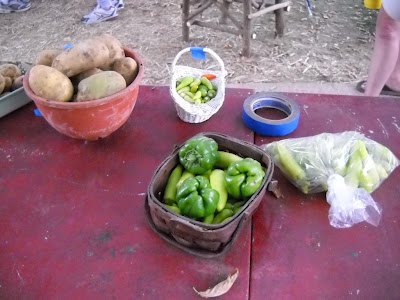 While vendors at the Colorado markets were numerous, only five vendors showed up to participate in the Newton County market on the Friday in early July when my mom showed up to take these photos as my proxy. She found four fruit and veg vendors and one craftsman. One of the food vendors had not only fresh produce, but also home-baked goods and jams and relishes for $5 each. That’s less than half the $11/jar cost at Mountain Village. Tomatoes were $6/lb in Colorado, but only $2.25 in Newton County (and my mom declared them the best she’s ever eaten). The selection wasn’t extensive — certainly none of the kohlrabi features at the Mountain Village market–but it included some potatoes, peppers, and squash. (You will note that the displays also were not as flashy as those in the upmarket Colorado towns). I suspect most vendors simply brought excess bounty from their own gardens, and that they did not decide what to plant because of the existence of the market. I don’t believe any of the vendors are engaged in agritourism, but I suspect those selling jams and relishes don’t also market those at the nearby gift shops on Scenic Highway 7 (see the figures below). No one at this market is making a living off the market, which is quite different to what I learned about the Colorado markets.
While vendors at the Colorado markets were numerous, only five vendors showed up to participate in the Newton County market on the Friday in early July when my mom showed up to take these photos as my proxy. She found four fruit and veg vendors and one craftsman. One of the food vendors had not only fresh produce, but also home-baked goods and jams and relishes for $5 each. That’s less than half the $11/jar cost at Mountain Village. Tomatoes were $6/lb in Colorado, but only $2.25 in Newton County (and my mom declared them the best she’s ever eaten). The selection wasn’t extensive — certainly none of the kohlrabi features at the Mountain Village market–but it included some potatoes, peppers, and squash. (You will note that the displays also were not as flashy as those in the upmarket Colorado towns). I suspect most vendors simply brought excess bounty from their own gardens, and that they did not decide what to plant because of the existence of the market. I don’t believe any of the vendors are engaged in agritourism, but I suspect those selling jams and relishes don’t also market those at the nearby gift shops on Scenic Highway 7 (see the figures below). No one at this market is making a living off the market, which is quite different to what I learned about the Colorado markets.
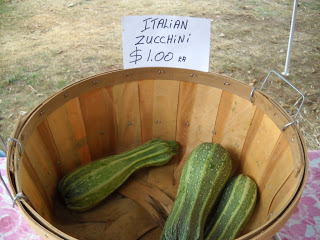 All of the vendors at the Newton County market were from within the county, population 8,264. I suppose it is not a sufficiently attractive market in terms of income potential to draw vendors from a wider area. And I suspect most if not all vendors brought excess bounty from their own gardens, that they had not decided what to plant because of the existence of the market. I don’t believe any of the vendors are engaged in agritourism, but I’d be surprised if those selling jams and relishes don’t also market those at the nearby gift shops on Scenic Highway 7.
All of the vendors at the Newton County market were from within the county, population 8,264. I suppose it is not a sufficiently attractive market in terms of income potential to draw vendors from a wider area. And I suspect most if not all vendors brought excess bounty from their own gardens, that they had not decided what to plant because of the existence of the market. I don’t believe any of the vendors are engaged in agritourism, but I’d be surprised if those selling jams and relishes don’t also market those at the nearby gift shops on Scenic Highway 7.
As I was drafting this, I found U.S. Government data on some of the very questions I was addressing. Here’s the county-to-county comparison on a range of data points related to agriculture, from the Atlas of Rural and Small-Town America:
- Principal Operator 10 years or more on same parcel: San Miguel County, 87; Newton County, 439
- Principal Operator 2 years or less on same parcel: San Miguel County, 1; Newton County, 35.
- Number of farms: San Miguel County, 123; Newton County, 636.
- Percentage of land being farmed: San Miguel County, 18.3; Newton County, 21.5%.
- Average Market Value of Product Sold: San Miguel County, $27,235; Newton County $29,907.
- Average Government Payment 2007: San Miguel County, $9230; Newton County, $1756.
- Percentage of Farms with income from Agritourism: San Miguel County, 4.87%; Newton County, 0.47%.
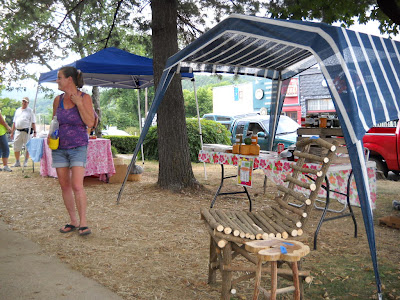 |
| Note the small market, and the wooden chairs for sale by one vendor. |
Source:



